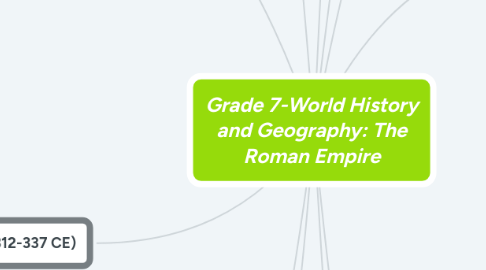
1. The Roman Empire-Catherine Saullo
2. The Roman Empire
2.1. 30 BCE-476 CE- The term “Roman Empire” refers to the time period, beginning with Augustus, when Rome was ruled by emperors
2.2. Activity-Virtual Tour of Imperial Rome Digging through time (video) | Ancient Rome | Khan Academy
3. Octavian becomes Augustus, who said, “I found Rome a city of bricks and left it a city of marble.”
3.1. Octavian was sole ruler of Rome after his forces defeated Antony and Cleopatra at the Battle of Actium
3.2. The Senate gave him the name “Augustus,” meaning “most high”
3.2.1. 23 BCE – Octavian, now referred to as Augustus, was made consul for life by the Senate .
3.2.1.1. He had the power to call the Senate, veto the Senate’s laws, and make laws himself
3.3. Rome under Augustus – a golden age
3.3.1. Attempted to reform public morals by promoting family life (largely unsuccessful). He began the practice of declaring emperors gods, and of picking their own successors. He called Haley’s Comet the spirit of Caesar. He built and maintained the empire’s infrastructure, roads. He encouraged the growth of business. He established fire and police departments for Rome. Established a strong money system. Finally, Jesus, the founder of Christianity, was born in the Roman province of Judea during the reign of Augustus.
3.4. Activity: Pass out Biography Graphic Organizer at the beginning of the lesson then break them up into groups of four (4) to compare and contrast
4. Constantine (312-337 CE)
4.1. Moved the capital from Rome to Byzantium
4.2. Constantine and Christianity
4.2.1. His mother, Helena, had converted to Christianity
4.2.2. Christianity started in the Roman province of Judea
4.2.2.1. Renamed the city Constantinople. Today the city is Istanbul (in modern Turkey)
4.2.2.2. Christianity legalized (religious toleration) Constantine converted to Christianity on his deathbed
4.2.2.3. Pax Romana and Roman infrastructure
4.2.2.3.1. Early Christians, as residents/citizens of the Roman Empire, could travel freely throughout the empire. There was a significant number of Christians in Rome by 64 CE, the year Nero blamed them for the fire (circa 30 years after Jesus died). According to tradition, Paul of Tarsus (St. Paul) used his Roman citizenship to have his criminal trial relocated to Rome from Caesarea (in Judea-Palestine) in the 60s CE
4.2.2.3.2. Christianity finally gained acceptance with the Edict of Milan (313 CE) and Constantine’s conversion
5. Justinian (527-565 CE)
5.1. Powerful emperor of the Eastern (Byzantine) Empire headquartered at Constantinople. Married Theodora, an intelligent courtesan
5.1.1. Managed to reunite the Eastern and Western empires for a time, but this did not last
5.1.1.1. Rewrote Roman law (Corpus Juris Civilis, or the Justinian Code). It is still the basis for civil law in several countries
5.1.1.1.1. Plague of Justinian (541-542 CE). The Bubonic plague severely hurt the Byzantine Empire. The Emperor Justinian became sick, but recovered. The recovery for the Byzantine Empire took hundreds of years
6. The two empires
6.1. Emperor Diocletian had believed that dividing the empire for administrative purposes would strengthen the empire. However, once Constantine set up Constantinople as a capital city, the east/west split deepened
6.2. The Western (Roman) Empire officially ended in 476 CE when the last emperor, Romulus Augustus, was deposed by a barbarian, Odoacer.
6.3. Eastern (Byzantine) Empire lasted until 1453 when the empire was conquered by the Ottoman Turks.
7. Everlasting contributions
7.1. The sculptures, bust, paintings and mosaic
7.2. Engineering
7.3. Colosseum
7.4. Roman baths
7.5. Roman numerals
7.6. Roman law
7.7. Literature
8. The Roman Republic
8.1. Rome first grew into power as a Republic
8.2. Rome's Leader's, such as senators, were elected officials that served fora limited amount of time, not kings, who were born into leadership and ruled for life.
8.3. Roman districts were divided into two distinct classes: the patricians and plebeian
8.3.1. Patricians were the wealthy and aristocratic
8.3.2. Plebeian were the rest
8.4. They had a complex government with written laws, a constitution, and a balance of powers. These concepts became very important in forming future democratic governments, like the United States.
9. Primus inter pares
9.1. “First among equals”
9.1.1. Being “first among equals” gave the illusion that an emperor was the most prestigious and important member of the Roman Senate, but that each senator was simultaneously equally important. In reality, the Roman emperors ruled with little input from anyone else

